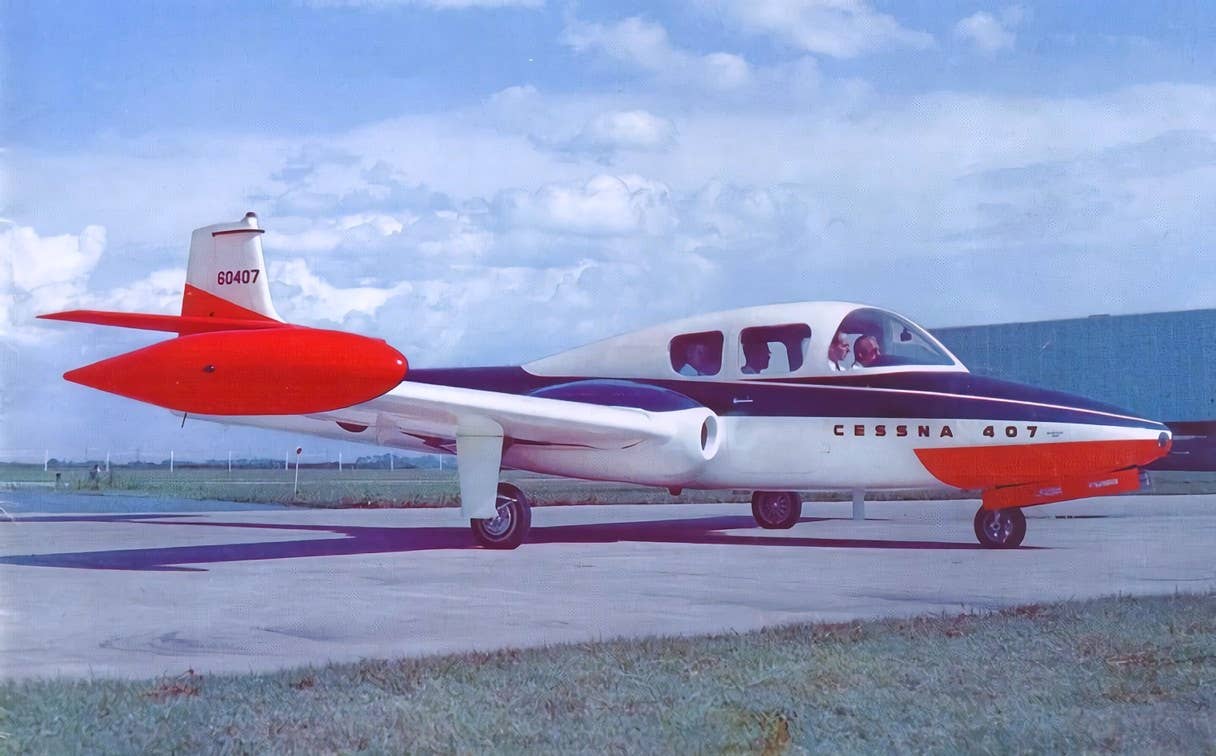Cessna 407: Full Steam Ahead, Right Up Until the End
The aircraft was based on a T-37 ‘Tweet’ primary jet trainer modified for civilian use.

Cessna’s Model 407 mock-up was marketed to both military and civilian customers but was ultimately canceled before a flying prototype was completed. [Courtesy: Cessna]
The late 1950s and early ’60s saw a frenzy of aircraft development. Largely driven by military contracts that called for a specialized type dedicated to each role, variety abounded, and unique designs emerged to address the many military requirements of the era.
Cessna was no exception, and it took an interesting approach to developing a new model in September 1959.
Historically, Cessna would modify civilian types for military use. For example, the 310 became the U-3, the 185 became the U-17, and the 172 became the T-41. In the case of the 407, the company reversed the process, using the existing T-37 “Tweet” primary jet trainer as a starting point and modifying it for civilian use. By installing new engines and modifying the cabin section, it aimed to convert the two-place military trainer into a comfortable, four-place personal jet.
There was some precedent for this new category of aircraft. Just seven months prior, French manufacturer Morane-Saulnier introduced the MS.760 Paris, a four-place jet with similar dimensions. With both military contracts and civilian sales secured, Morane-Saulnier appeared to have found multiple markets and would ultimately go on to build more than 200 examples.
Never one to happily cede market share, Cessna observed that it could pursue the blossoming personal jet market and also possibly secure some additional military contracts with minimum investment. By utilizing many of the same components and tooling as the T-37, much of the necessary development work could be avoided. Building a full-scale wooden mock-up and beginning construction of the first prototype, the marketing group began a sales tour, pitching the concept at various locations around the U.S.
Outwardly similar to the T-37, the 407 utilized the same tail section and wing as the jet trainer but repositioned the engine nacelles 9 inches outward to create more internal space. The cabin utilized this additional space to accommodate four passengers and their baggage. Occupants could easily step into the low-slung cabin without the need for separate steps or ladders, a welcome change from the MS.760, which required occupants to climb a stepladder and clamber into the cockpit from above—decidedly unsophisticated for the target customers of luxurious private jets.
Like the MS.760—but unlike the T-37—the 407 would incorporate a pressurized cabin for passenger comfort. This helped to enable a rather impressive service ceiling of 46,400 feet, some 13,000 higher than that of the French jet. At a more typical cruising altitude of 35,000 feet, the 407’s cabin altitude would have been maintained at a reasonable 8,000 feet.
Performance-wise, Cessna promised some fairly impressive numbers. With a 4,657-pound empty weight and 9,300-pound gross weight, the team boasted a range of 1,380 nm and a maximum level speed of 423 knots. The stall speed was listed as a relatively low 84 knots, making the jet capable of accessing runways of around 3,000 feet in length.
Ultimately, like some other intriguing concepts from Cessna, the 407 was not to be. The mock-up pictured was, in fact, a T-37 with a wooden cabin section. And while construction of actual cabin sections was underway, the entire 407 project was abandoned in favor of the massively successful Citation family, the first of which flew in 1969. Interestingly, the FAA registry shows that Cessna registered a 407 as N34267, with serial number 627, indicating the project was full steam ahead, right up until the end.

Sign-up for newsletters & special offers!
Get the latest FLYING stories & special offers delivered directly to your inbox






